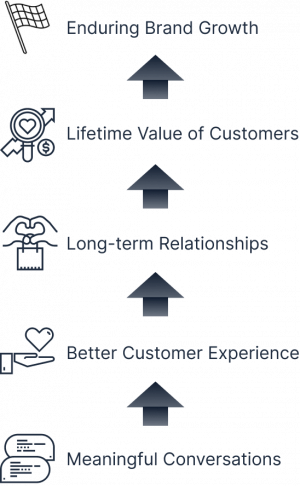
Three Things We’re Doing Now to Prepare for the Future of Digital Media
Luckily, cookies are going away. For years, Google has been preparing to eliminate cookies — a change that will dramatically alter the digital marketing landscape. The Wall Street Journal and other authors claim advertisers are not ready.
No cookies, no problem. There is a solution. Since its inception, Google data only tells us people are looking for. Google data does not tell us why people are looking. If you don’t know why, you don’t know your customer.
Cookies allow advertisers to target people accurately and follow them across the internet. But CRM has never delivered on the promise of genuine customer relationships. That is because most digital media simply finds consumers and then stalks them. What kind of relationship involves stalking? We believe brands should connect with their customers in a far more empathic way. No more interrupting their life. No more stalking. Here are three steps we’re taking now to address this shift.
1) Start with more insightful targeting.
Cookies provide data. Data is not insight. Data tells us what people did. Data does not provide why they did it. Eliminating cookies will force marketers to rely on insight — not data. Our definition of insight is a fresh, intimate understanding of people’s beliefs that has the power to genuinely change behavior. Insight requires filtering data through empathy. Insight is the key to a long-term relationship.
Long-term relationships are the lifeblood of strong brands. They are a win for both the customer and the brand. Nowhere is this more important than in life’s most critical journeys, like healthcare.
A recent Harris poll says that over 70 percent of patients want stronger relationships with their providers. Most believe their health would improve if they regularly worked with a trusted healthcare provider. Too many patient interactions are transactional. These impersonal interactions do not help patients. And they do not help healthcare providers’ bottom line. Most providers do not connect with people in a way that helps patients get the care they need when they need it. As a result, providers face a lack of brand trust, finding it challenging to build lifelong patient relationships.
To be effective, precision marketing must start with insight — the insight that comes from a customer journey. Brands have used customer journeys to inform media and messaging for years. Some brands are sophisticated enough to overlay the physical journey with their customer’s emotional journey. Adding the emotional journey allows the brand team to not only know the steps their customer takes, but also helps the brand team intuitively understand their customer. The emotional journey begins to tell us why.
But knowing both the physical steps — and the emotions felt during those steps — is not enough. Truly helpful journeys combine data science and empathy. They reveal what your customers want and every question they have in every moment that matters in their journey. And knowing what people want, why they want it, and when they want it, can help your media work harder.
2) Pivot to cookie-free targeting solutions
In the case of some channels, like direct-to-consumer targeting, upcoming changes have been largely publicized. For that reason, we started tracking and adjusting in 2022.
With every campaign, we either avoid leveraging cookie-reliant third-party data segments or track emerging cookie-free platforms like Google Data Privacy Solutions, which is still in development. Early tests show features like auto-tagging, and enabling enhanced attribution and enhanced conversions will help. Ensuring Google Analytics 4 (GA4) is properly functioning and updated is also vital. GA4 was designed to adapt to a future without third-party cookies, using machine learning modeling and data-driven attribution to fill in the gaps. More cookie-free tactics to try include:
- First-party data (cookie-free remarketing on DV360)
- First-party data modeling (aka lookalike targeting)
- First- and second-party data of partners like Google, Dstillery, PulsePoint, and other publishers (like the Wall Street Journal, the New York Times, Fast Company, Bloomberg, and Dotdash Meredith)
- Contextual targeting
3) Embrace capturing zero-party data with conversational AI
The introduction of conversational AI changes everything. With conversational AI, we go from interrupting and stalking our customers to having real conversations. Those better conversations provide meaningful customer experiences. We move from transactions to long-term relationships, allowing brands to capture the value of their customers throughout their lifetime. And that means significant and enduring growth.
Conversational Engagement™ Benefit

The brands and businesses most likely to benefit from conversational AI will be in complex categories like healthcare and higher education. These categories have high-value journeys where consumers need education and guidance. Businesses in these categories thrive when the customer and brand benefit from an enduring relationship throughout the customer’s journey.
For conversational AI to work, brands will need much more than ChatGPT or Copilot. While amazing, those platforms are designed to answer every question from any person on earth. They are the jack-of-all-trades, master of none. But when it comes to making a difference in a person’s life, the AI must be focused. It must be personal. The AI must be the master of the most important journey of your customer’s life. For example, if I have cancer, I want the best oncologist on earth. I love my primary care physician, but I want a specialist that stays with me throughout my journey. Businesses with high-value journeys will need purpose-built models. They will need to train their AI to be as focused as their customers are in those moments that matter.
Brands must embrace conversational AI, but they need real insight to make those critical conversations meaningful for their customers. When that happens, everybody wins.
And no one will care about cookies anymore.